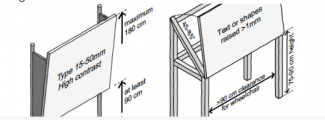Submitted by
ManuelRothe
on
Tue, 12/10/2019 - 18:42
Access to timely information can save lives. Here are a few tips on making information accessible and more available for everyone:
- Consult with persons with disabilities, older persons and persons from cultural minorities on their preferred means of communication.
- Test the information with women, men and children from these groups to understand their barriers to receive, process and understand information. Consider: blind people, deaf people, people who are hard of hearing, people with psychosocial disabilities, people with intellectual impairments, and people who cannot read or write.
- Ensure that information material is made available in multiple formats using different technologies, such as SMS, radio, TV, but also written information, billboards and through meetings or trained volunteers providing information house-to-house.
- Ensure that information material uses gender-, disability- and culturally sensitive language and imagery.
- Provide easy-read versions of relevant documents.
When using printed material:
- Use strong contrast colours;
- Use simple typeface (Arial, Calibri) and font size minimum 12 and provide a copy with drawings;
- Use large dark print (at least 10 cm letters for 3 m viewing distance/ 20 cm for 10 m distance).
- Make sure to provide large print versions of print materials.
When using audio material:
- Use audio signal for preparedness, street campaigns and sensitization;
- It is preferable to have a larger number of quieter alarms rather than a few very loud ones, in order to achieve a more even distribution of the signal;
- Audio material should be combined with printed material.
When using electronic material
- Use strong contrast colours;
- Use large font (minimum 12), avoid italic font;
- Include option for enlarging text;
- Design an accessible website, see resources below.
When using information boards
- Place them at a height easily readable for a wheelchair user and younger children, 75-90 cm above the ground and maximum 180 cm high.

© AUOR 2015
Information can be shared using tactile maps, which can be read by persons with visual impairment.

© CBM/Benjamin Dard
Sources
European Agency for Special Needs and Inclusive Education, Guidelines for accessible information, 2015